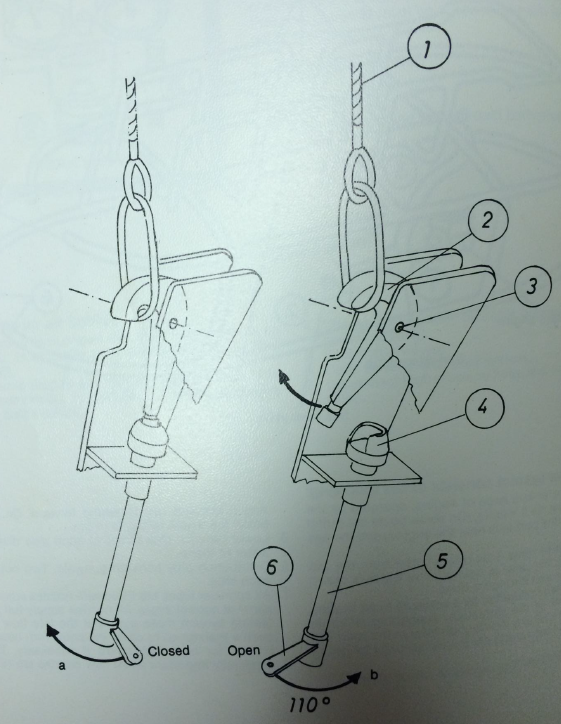Failure of lifeboat release hook mechanism
A member has reported a recent high potential incident involving the failure of a lifeboat release hook mechanism. The incident took place during the quarterly mandatory lifeboat lowering operations. The forward release hook mechanism opened resulting in the lifeboat dropping into a vertical position, but remaining suspended from the aft hook. Four persons where onboard the lifeboat at the time, but were uninjured.
The release hook system in place onboard the vessel is of the Schat-Harding H-80, ‘on-load’ release type. The basic overview of the system is shown in the figure on the left, with the components noted below.
The mechanism is operated from the aft release point, with both hooks disconnected and engaged simultaneously through operation of the aft release mechanism. A linkage rod connects the aft mechanism to the forward mechanism to enable this single instantaneous operation.
The locking lever (component 6) is twisted 110 degrees at the aft release point and this command is replicated at the forward hook release and the main hook lever (locking cup)(component 4) latches or unlatches the release hook.
The current design of the system does not give the operator direct indication that the forward hook is correctly locked. A single indicator serves both the Master (aft) and Slave (forward) locking systems, but only the position of the aft hook is positively indicated.

| Item | Component |
|---|---|
| 1 | Davit fall |
| 2 | Aft hook |
| 3 | Hook pivot point |
| 4 | Main hook lever |
| 5 | Locking shaft |
| 6 | Locking lever |
Our member’s preliminary investigation noted the following:
- The hook release mechanism linkage was found to have failed (sheared) -see Figure 2 -at the forward end of the lifeboat. This is likely (pending final report) to have been caused by misalignment of the hook during re-attachment and/or fragile design of the hook release mechanism linkage;
- Further inspection onboard found that the forward release mechanism linkage was severely bent (See Figure 3) in one of the other three lifeboats;
- As a result of the above noted damage, a total of two of four lifeboats were found to have release hooks that were not fully engaged.
- Immediate inspection of all lifeboat release hook mechanisms, irrespective of design with the following pointers:
The company has recommended that the following actions are taken:
- Check for integrity and potential damage
- Ensure that the latching mechanism is fully engaged;
- Ensure that there are ‘routine’ checks that all hooks are engaged prior to launch, on completion of recovery and during ‘routine’ lifeboat inspections.

This photograph shows the linkage rod that sheared on the forward release hook mechanism on the failed lifeboat. With the linkage sheared, the lifeboat release hook was not fully engaged, resulting in the hook releasing.

This photograph shows the release hook mechanism linkage at the forward locking mechanism. The arrow indicates the area of severe deformation of the linkage rod, caused by the misalignment of the hook and/or fragile design. The blue line represents the correct alignment of the linkage rod. In this condition, the lifeboat hooks are not fully engaged.
Members may wish to refer to the following similar incidents (key words: dropped, lifeboat, release, mechanism)
Safety Event
Published: 17 July 2014
Download: IMCA SF 13/14
IMCA Safety Flashes
Submit a Report
IMCA Safety Flashes summarise key safety matters and incidents, allowing lessons to be more easily learnt for the benefit of all. The effectiveness of the IMCA Safety Flash system depends on Members sharing information and so avoiding repeat incidents. Please consider adding [email protected] to your internal distribution list for safety alerts or manually submitting information on incidents you consider may be relevant. All information is anonymised or sanitised, as appropriate.
IMCA’s store terms and conditions (https://www.imca-int.com/legal-notices/terms/) apply to all downloads from IMCA’s website, including this document.
IMCA makes every effort to ensure the accuracy and reliability of the data contained in the documents it publishes, but IMCA shall not be liable for any guidance and/or recommendation and/or statement herein contained. The information contained in this document does not fulfil or replace any individual’s or Member's legal, regulatory or other duties or obligations in respect of their operations. Individuals and Members remain solely responsible for the safe, lawful and proper conduct of their operations.
